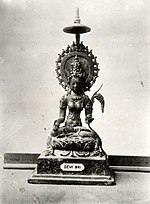Kakawin Bhomantaka
Old javanese kakawin
You can help expand this article with text translated from the corresponding article in Indonesian. (December 2022) Click [show] for important translation instructions.
- View a machine-translated version of the Indonesian article.
- Machine translation, like DeepL or Google Translate, is a useful starting point for translations, but translators must revise errors as necessary and confirm that the translation is accurate, rather than simply copy-pasting machine-translated text into the English Wikipedia.
- Do not translate text that appears unreliable or low-quality. If possible, verify the text with references provided in the foreign-language article.
- You must provide copyright attribution in the edit summary accompanying your translation by providing an interlanguage link to the source of your translation. A model attribution edit summary is
Content in this edit is translated from the existing Indonesian Wikipedia article at [[:id:Kakawin Bhomântaka]]; see its history for attribution. - You may also add the template
{{Translated|id|Kakawin Bhomântaka}}to the talk page. - For more guidance, see Wikipedia:Translation.
Kakawin Bhomantaka is an Old Javanese Hindu Kakawin written around the 12th century. It is one of the longest Kakawins, being composed of nearly 1,500 stanzas, with a total of about 6,000 total lines of verse.[1][2][3]
Cultural impact
The Bomantaka, despite being composed in Java, has been forgotten entirely from there, but still lives on in Bali, where it is embedded in the local culture, and has been continuously sung, read, performed, and transmitted.
References
- ^ Teeuw, A; Robson, S. O. (Stuart Owen); Koninklijk Instituut voor Taal-, Land- en Volkenkunde (Netherlands) (2005), Bhomāntaka : the death of Bhoma, KITLV Press, ISBN 978-90-6718-253-9,
so that a tentative dating to the twelfth century seems justified, with East Java as location. This means that the text is now at least eight hundred years old
- ^ Meij, Dick van der; ProQuest (Firm) (2017), Indonesian manuscripts from the islands of Java, Madura, Bali and Lombok, Leiden Boston Brill, ISBN 978-90-04-34811-0
- ^ Molen, W. van der (Willem); Ding, Choo Ming; ISEAS-Yusof Ishak Institute, (issuing body.) (2018), Traces of the Ramayana and Mahabharata in Javanese and Malay literature, ISEAS Publishing, ISBN 978-981-4786-58-4
 | This poetry-related article is a stub. You can help Wikipedia by expanding it. |
- v
- t
- e
 | This Hindu mythology–related article is a stub. You can help Wikipedia by expanding it. |
- v
- t
- e















